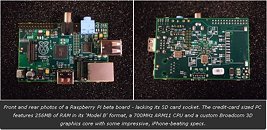qubit
Overclocked quantum bit
- Joined
- Dec 6, 2007
- Messages
- 17,865 (2.87/day)
- Location
- Quantum Well UK
| System Name | Quantumville™ |
|---|---|
| Processor | Intel Core i7-2700K @ 4GHz |
| Motherboard | Asus P8Z68-V PRO/GEN3 |
| Cooling | Noctua NH-D14 |
| Memory | 16GB (2 x 8GB Corsair Vengeance Black DDR3 PC3-12800 C9 1600MHz) |
| Video Card(s) | MSI RTX 2080 SUPER Gaming X Trio |
| Storage | Samsung 850 Pro 256GB | WD Black 4TB | WD Blue 6TB |
| Display(s) | ASUS ROG Strix XG27UQR (4K, 144Hz, G-SYNC compatible) | Asus MG28UQ (4K, 60Hz, FreeSync compatible) |
| Case | Cooler Master HAF 922 |
| Audio Device(s) | Creative Sound Blaster X-Fi Fatal1ty PCIe |
| Power Supply | Corsair AX1600i |
| Mouse | Microsoft Intellimouse Pro - Black Shadow |
| Keyboard | Yes |
| Software | Windows 10 Pro 64-bit |
We have previously reported on the super cheap ARM-based Raspberry Pi hobby computer that's been under development from the Raspberry Pi foundation. However, it's now going into production and is generating a lot of interest, so gamesindustry.biz interviewed its founder, Eben Upton, about it (free registration required).
The computer's primary purpose is as a computer science teaching aid in schools and colleges and also for home brew use by enthusiasts who want to tinker with it and make specialized solutions out of it. However, it seems that enthusiasts will have a nice surprise in that the onboard GPU is surprisingly good. The actual ARM implementation is a Broadcom BCM2835 System on Chip (SoC) containing an ARM 11 CPU and a custom graphics core, which has been designed by the Raspberry Pi team, including Upton. In the interview, Upton claimed that it can double iPhone 4S performance and handily beats NVIDIA's Tegra solution, because of its tile mode architecture.

"Q: We know that you have a 700MHz ARM11 core in the Raspberry Pi SoC. However, you've described the Broadcom chip as a GPU with ARM elements grafted on. Can you give some idea of the rendering power of the graphics core? Is it true that it comprehensively outperforms NVIDIA's Tegra 2? If so, how?
Eben Upton: I was on the team that designed the graphics core, so I'm a little biased here, but I genuinely believe we have the best mobile GPU team in the world at Broadcom in Cambridge. What's really striking is how badly Tegra 2 performs relative even to simple APs using licensed Imagination Technologies (TI and Apple) or ARM Mali (Samsung) graphics. To summarise, BCM2835 has a tile mode architecture - so it kills immediate-mode devices like Tegra on fill-rate - and we've chosen to configure it with a very large amount of shader performance, so it does very well on compute-intensive benchmarks, and should double iPhone 4S performance across a range of content."
There don't appear to be any objective benchmarks to prove this at the moment, so we will have to take his word for it for now. Of course, this little computer isn't a one trick pony and can do many other things, such as offering full support for 1080p30 Blu-ray h.264 files, making it a competent media player. Also, it runs Linux, which is highly customizable and has a good selection of interfaces, such as USB 2.0, SD, HDMI, RCA video, analog audio and a 10/100 Ethernet port. It is also capable of supporting various expansion boards.
View at TechPowerUp Main Site
The computer's primary purpose is as a computer science teaching aid in schools and colleges and also for home brew use by enthusiasts who want to tinker with it and make specialized solutions out of it. However, it seems that enthusiasts will have a nice surprise in that the onboard GPU is surprisingly good. The actual ARM implementation is a Broadcom BCM2835 System on Chip (SoC) containing an ARM 11 CPU and a custom graphics core, which has been designed by the Raspberry Pi team, including Upton. In the interview, Upton claimed that it can double iPhone 4S performance and handily beats NVIDIA's Tegra solution, because of its tile mode architecture.

"Q: We know that you have a 700MHz ARM11 core in the Raspberry Pi SoC. However, you've described the Broadcom chip as a GPU with ARM elements grafted on. Can you give some idea of the rendering power of the graphics core? Is it true that it comprehensively outperforms NVIDIA's Tegra 2? If so, how?
Eben Upton: I was on the team that designed the graphics core, so I'm a little biased here, but I genuinely believe we have the best mobile GPU team in the world at Broadcom in Cambridge. What's really striking is how badly Tegra 2 performs relative even to simple APs using licensed Imagination Technologies (TI and Apple) or ARM Mali (Samsung) graphics. To summarise, BCM2835 has a tile mode architecture - so it kills immediate-mode devices like Tegra on fill-rate - and we've chosen to configure it with a very large amount of shader performance, so it does very well on compute-intensive benchmarks, and should double iPhone 4S performance across a range of content."
There don't appear to be any objective benchmarks to prove this at the moment, so we will have to take his word for it for now. Of course, this little computer isn't a one trick pony and can do many other things, such as offering full support for 1080p30 Blu-ray h.264 files, making it a competent media player. Also, it runs Linux, which is highly customizable and has a good selection of interfaces, such as USB 2.0, SD, HDMI, RCA video, analog audio and a 10/100 Ethernet port. It is also capable of supporting various expansion boards.
View at TechPowerUp Main Site











